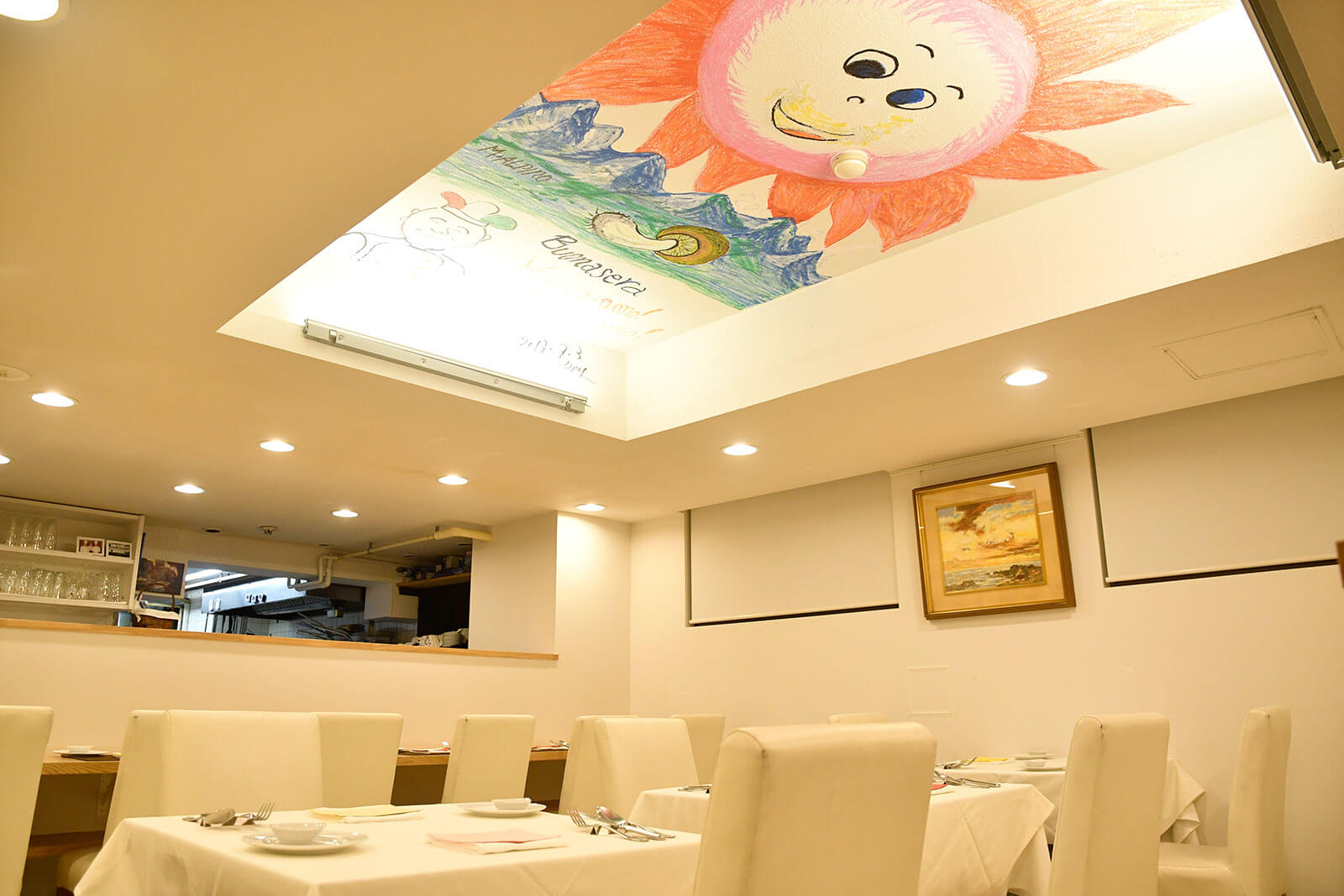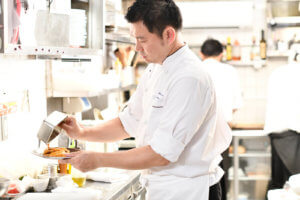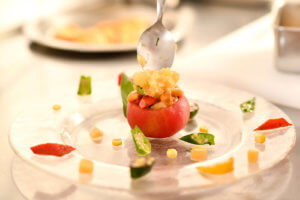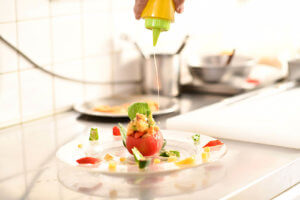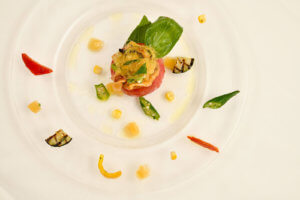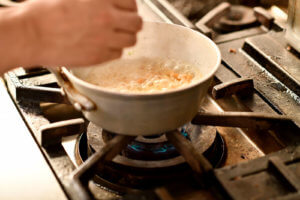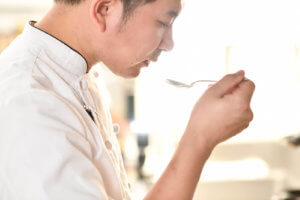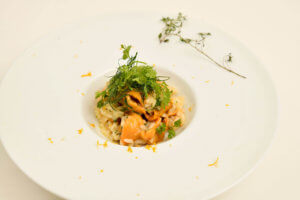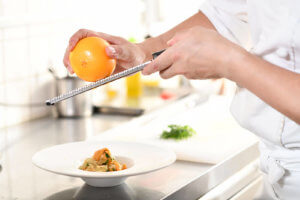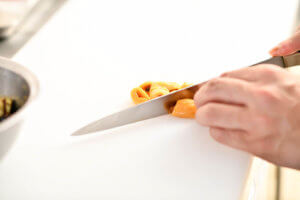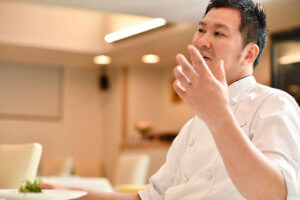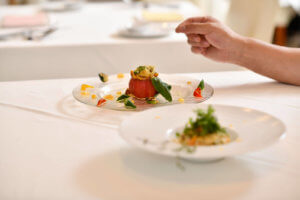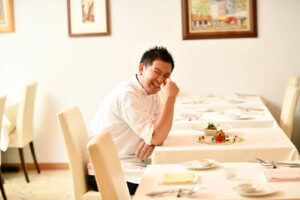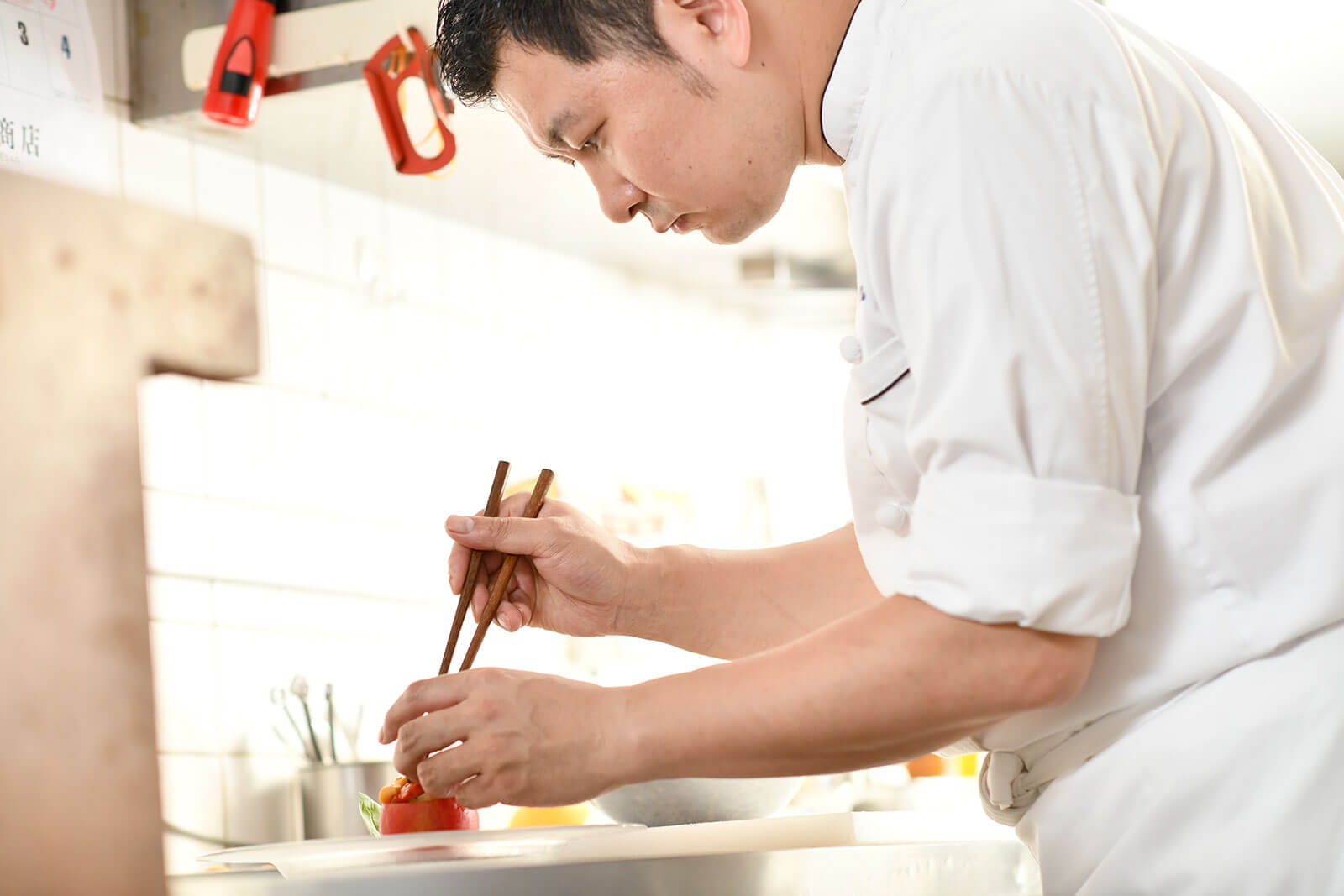
“1 + 1 = 2” means nothing: the synergistic effect of using sea pineapple with other ingredients leads to something more
The first dish that we will discuss is sea pineapple and summer vegetables with jelly. The main ingredient of the dish is sea pineapple accompanied by tomato. Since I thought that sea pineapple and tomato go well together, in addition to sea pineapple, I stuffed one tomato with eggplant, paprika, corn, and okra using different cooking methods. The sea pineapple was mixed with olive oil, a small amount of salt, and Italian parsley, serving it in a simple manner just as if it was raw. I think that it can be served with basil for a feeling of coolness, and the combination of ingredients can be enjoyed by customers themselves as they eat.
I placed jelly on top of it made from solidified sea pineapple soup stock. However, placing sea pineapple jelly on top of sea pineapple does not produce a synergistic effect. As an accent to further complement it, a transparent extract extracted for a period of one hour from tomato seeds was added. Summer is a season during which both vegetables and sea pineapple taste delicious, but used together will lead to something less than expected, in which 1 + 1 becomes 1.5 rather than 2.
Because I want to create a synergistic effect that well exceeds expectations in which 1 + 1 becomes 3.5, I mildly marinate the tomato itself, remove any liquid, and make the jelly so that it is somewhere between hard and soft, imagining its consistency while in the mouth and its mariage (pairing) with white wine.
The second dish that we will discuss is a risotto. It was cooked in one pot with the sea pineapple absorbed by the rice spreading its flavor. In addition, although I thought about adding soup stock containing sea pineapple extract, I chose to use quite a light vegetable bouillon instead. This is because although sea pineapple itself is delicious, you don’t want to overdo it. I also added dill which goes well with seafood, sesame flavor, rucola selvatica for a bit of emphasis, and thyme, which when heated has more flavor, adding a refreshing sensation and accent to the dish.
For its finishing touch, initially I thought about using lemon. In Sicily, sea pineapple is called “sea lemon.” Although I thought that sea pineapple and lemon would go well together, I imagined it being a bit too sour. It may have had a function such as getting rid of the smell of the meat due to a strong level of sourness, but there was absolutely no need for that in this case as this sea pineapple did not smell bad at all. I decided to use orange which is also sweet, reflecting my own originality. I think this is a combination that produces a synergistic effect in which 1 + 1 becomes 3 rather than 2.
I think restaurant cooking is something that is delicious, something in which discoveries can be made, and something that can surprise people. Especially if it is something that I do, I want it to bring out my ideas and particular tastes, and, if someone wants to do something, the person with imaginativeness is the interesting one. In addition, since I think that being a chef it is a profession that involves changing fixed concepts, I want people to say that foods that they originally disliked are delicious as a result of changing their form in some way. Although there were some customers didn’t know what sea pineapple was and others who didn’t like it, after recommending it to them, they ate every last bit of it. More than anything, I personally think that it is delicious and recommended it with confidence, so I think that the customer was safe to say “I will try it then.”
Senrei’s CAS (Cells Alive System) product lineup meets the needs of the times
When using this product, I place the amount I want to use in the refrigerator the previous night, allow it to thaw, and then use it as is. Packages that can be divided are also nice. To be honest, talking about restaurants our size, we need to make purchases while considering various risks, such as what we should do if we are in short supply. Even if it is prepared, it might not match what the
customer is looking for. On the other hand, there are also people who order a la carte. In these cases as well, Senrei Sea Pineapple is really easy to handle. However, it goes without saying that there are many people that do not know about sea pineapple, so if we did not list it on the menu, guests would have asked what it was. We always list the ingredients used in allergy information sections to make guests aware of what they are eating. We just cut sea pineapple in half but a guest might not recognize it simply based on how the dish looks. I think that there are also people who first learned about sea pineapple through this fair.
Italian cuisine is based on the taste and sweetness of the ingredients and combines these tastes. Sea pineapple is also an easy-to-handle ingredient because it expands the possibilities for ingredient combinations. I just cut it just a little this time and it requires hardly any preparation. I think that ideas regarding w to use sea pineapple will increase as the need for preparation diminishes. Sea
pineapple is definitely good served raw, and it takes a bit of time and effort to remove the shells of sea pineapple that is delivered in the shell. Senrei Sea Pineapple is caught and frozen using CAS freezing processing without the shell. Since not a few amount of processing has been optimally completed in the production area, the last issue concerns who will work their magic to make the sea
pineapple taste great.
If we say that freshness is most important, I think that customers will also understand. Since we live in a time in which efficiency is important, it is natural to choose such a product. I think that Senrei Sea Pineapple also falls in this category, making it a CAS freeze processed product that really matches the needs of the times.
Previous Wow! This sea pineapple is delicious!<
please contact:
Marusho, Inc.
5-2-1 Tsukiji, Chuo-ku, Tokyo, 104-0045
03-3543-6471
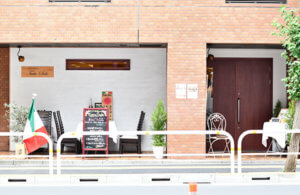
Osteria Tutto Sole “Osteria Tutto Sole” is in a two minute walk from the Central Exit of Oimachi Station located on the JR Keihin-Tohoku Line. The restaurant offers an Italian based menu using ingredients from the chef’s home prefecture of Hokkaido. We provide hospitality with delicious dishes and hearty service so that our customers will be satisfied.
Osteria Tutto Sole was opened in 2017, following the footsteps of Trattoria Yoshida, known as the restaurant owned by Masakuni Yoshida, author of Itaria Ryori Yogo Jiten(Dictionary of Italian Cuisine Terminology), and also held in high regard by Michelin. Since “Totte Sole” means “total sun,” there is a large picture of a sun said to be drawn by Mr. Yoshida and his associates which watches over the new restaurant with a smile.
